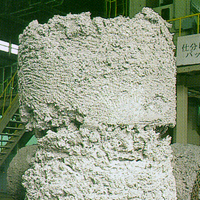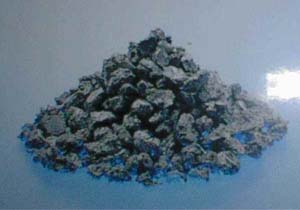|
Titanium sponge as a primary element in the production cycle of titanium metal

It is considered the first commercial form of the metal and its price is often cited as a primary basis for the analysis of the market fluctuations. Further processing leads to titanium ingots and mill products. Titanium sponge is the result of reducing titanium tetrachloride with magnesium in the Kroll process. It is called sponge because (doh…) of its sponge-like appearance. Sodium reduced metal (produced by the now almost extinct Hunter process) is also referred to as sponge. Titanium sponge is highly susceptible to contamination and deterioration since its sponge-like characteristics permit pickup of free moisture if improperly packed and stored.
The starting material of choice (natural and synthetic rutiles, and titaniferous slags - minerals that are composed mainly of TiO2 contaminated with other materials) is mixed with coke and fed to a fluidized bed where reaction with chlorine gas takes place at about 1,000 degrees Celsius. The major products of reaction are carbon monoxide, carbon dioxide, titanium tetrachloride (TiCl4) and other volatile metal chloride vapors, and nonvolatile residues of silicon, zirconium, and other materials.
Titanium metal is produced commercially from purified titanium tetrachloride by the Kroll process using elemental magnesium to reduce the titanium. The TiCl4 and magnesium are fed to reactors in which the temperature and composition of the reacting mixture are controlled carefully.
Titanium ingot is prepared by mixing the sponge with any required alloying agents, mainly aluminum and vanadium, and titanium scrap and melting the mixture under inert conditions in electron beam, plasma, or vacuum arc furnaces. On the other hand, titanium dioxide pigments are produced from the purified TiCl4 by reoxidizing it with purified oxygen. The gas phase reaction is carried out in stages with temperatures controlled from 900oC up 2,000oC. Mixing conditions, temperatures, and the addition of light metal chloride nucleating agents are controlled to give the particle size distribution desired in the final product. The solids produced under these conditions are in the rutile crystal form. In spite of the improvements that have been made over the years, the high cost and complexity of the Kroll process used to produce titanium sponge have provided ample incentives for researchers to attempt to develop alternate process routes. Many process variations and alternative chemistries have been investigated in the laboratory. A few have been tested at somewhat larger scale, but none have been commercialized. The FFC Cambridge4 process is the most advanced, it has demonstrated technical success at the bench, but numerous engineering and economic problems remain to be addressed before it can be commercialized.
Return from Titanium sponge to Titanium prices Return to Titanium Home Page
|
 The crude TiCl4 is purified to remove the iron chlorides, small amounts of radioactive materials, and other impurities that would be chromophores or otherwise detract from product performance. The purified, liquefied TiCl4 is the starting material for the production of both titanium metal sponge and titanium dioxide pigments.
The crude TiCl4 is purified to remove the iron chlorides, small amounts of radioactive materials, and other impurities that would be chromophores or otherwise detract from product performance. The purified, liquefied TiCl4 is the starting material for the production of both titanium metal sponge and titanium dioxide pigments.

